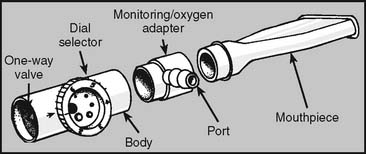7 Hyperinflation Therapy
Note 1: This book is written to cover every item listed as testable on the Entry Level Examination (ELE), Written Registry Examination (WRE), and Clinical Simulation Examination (CSE).
The listed code for each item is taken from the National Board for Respiratory Care (NBRC) Summary Content Outline for CRT (Certified Respiratory Therapist) and Written RRT (Registered Respiratory Therapist) Examinations (http://evolve.elsevier.com/Sills/resptherapist/). For example, if an item is testable on both the ELE and the WRE, it will be shown simply as: (Code: …). If an item is testable only on the ELE, it will be shown as: (ELE code: …). If an item is testable only on the WRE, it will be shown as: (WRE code: …).
MODULE A
1. Instruct the patient in deep-breathing techniques (Code: IIID1a) [Difficulty: ELE: R, Ap; WRE: An]
Teach the following cough techniques to the patient with obstructive airways disease:
2. Instruct the patient in inspiratory muscle training techniques (ELE code: IIID1b) [Difficulty: R, Ap]
Initially, teach the following steps to patients with obstructive airways diseases:
MODULE B
1. Instruct the patient in incentive spirometry techniques (Code: IIID1a) [Difficulty: ELE: R, Ap; WRE: An]
Because the goal of IS is to prevent or treat atelectasis, the patient should inhale a near-normal inspiratory capacity (IC). The patient can benefit more by holding the IC for several seconds, which is referred to as sustained maximal inspiration (SMI). Before the operation, the cooperative surgical patient should have the IC measured at the bedside or calculated from a pulmonary function test in which vital capacity (VC) is measured (review Chapter 4 for IC information). The IC is measured again postoperatively.
Monitor your patient’s progress in the following ways:
2. Increase or decrease the patient’s incentive spirometry goal (Code: IIIF2b) [Difficulty: ELE: R, Ap; WRE: An]
See Table 7-1 for IS guidelines. The following guidelines are also suggested:








